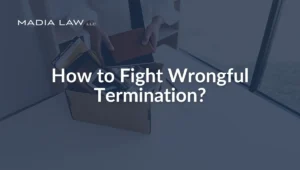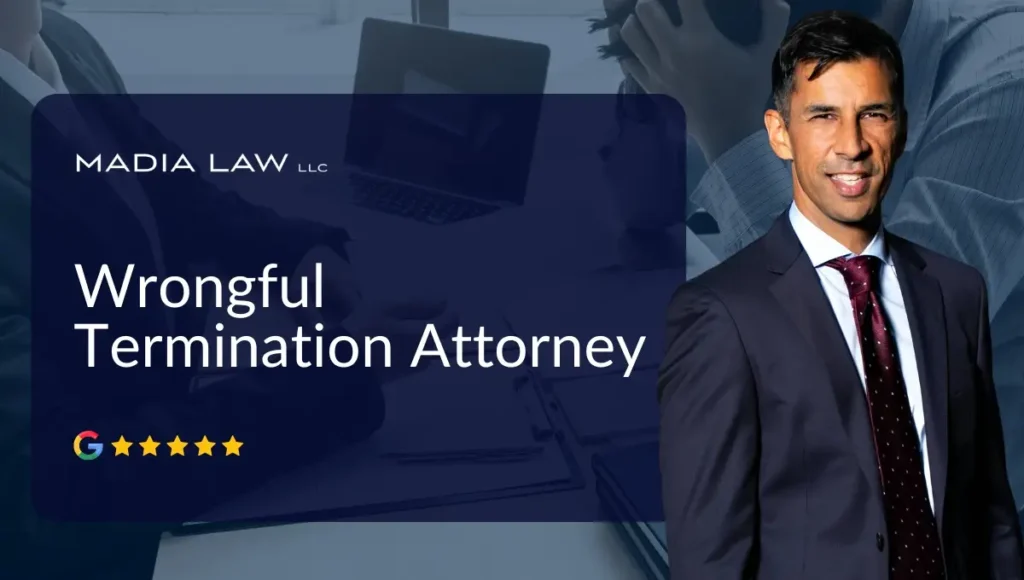
Losing your job unexpectedly, especially when you feel you have done nothing wrong, can be overwhelming, frustrating, and deeply personal. Under federal law applicable in Minnesota and all states, not every termination is lawful. If you were fired for an illegal reason, such as retaliation, discrimination, or after taking protected leave, you may have a strong claim for wrongful termination.
Fighting back effectively starts with understanding your rights. Employers cannot fire you for reasons that violate anti-discrimination laws, breach employment contracts, or punish you for whistleblowing or asserting your legal protections.
At Madia Law LLC, we help you understand how to fight wrongful termination by clearly identifying whether your firing was unlawful, determining what evidence you need, explaining the compensation you could recover, and guiding you through each step of legal action. You deserve answers, and we are here to help you get justice.
Key Takeaways
- You must prove your firing violated federal or Minnesota law to fight wrongful termination.
- Take immediate legal steps like gathering documents, contacting a lawyer, and filing with the EEOC.
- Key evidence includes emails, witness statements, complaint records, and timing of your termination.
- Unlawful reasons for firing include retaliation, discrimination, protected leave, and contract violations.
- You may recover lost wages, emotional damages, future earnings, or reach a settlement with your employer.
For a legal consultation, call 612-349-2729
Steps to Take If You Have Been Wrongfully Terminated
If you were wrongfully terminated, take specific legal steps immediately to protect your rights and strengthen your case. What you do in the first days after being fired can affect your ability to recover compensation or file a claim.
Follow these key steps to improve your legal position and prepare for action.
Write Down What Happened and Save All Communications
Create a detailed record of your termination, including dates, conversations, and warning signs. Document what led to your firing, who was involved, and how events unfolded.
Save all communication with your employer that relates to performance, complaints, or discipline. This includes emails, Slack messages, HR memos, and performance reviews.
These records support your wrongful termination claim by showing patterns of retaliation, discrimination, or unfair treatment.
Request Your Personnel File & HR Records
Request your personnel file from your employer, as allowed under Minnesota law. You have the legal right to see documents that relate to your performance and employment history.
Ask for evaluations, disciplinary records, manager notes, and any internal complaints you submitted. These documents often expose inconsistencies or reveal whether company policies were violated during your termination.
Reviewing your file is a key step in fighting wrongful termination and preparing your legal case.
Do Not Sign Severance or Exit Agreements Without Review
Never sign any severance or exit agreement before a lawyer reviews it. These documents may contain clauses that waive your right to sue for wrongful termination.
Quickly signing without legal advice can limit your ability to take action or recover compensation. Reviewing the agreement first protects your rights and supports your claim.
Consult an Employment Lawyer Early
Contact an employment lawyer as soon as possible after being fired. Early legal guidance helps you understand if your rights were violated and what action you can take.
An experienced lawyer will explain how to fight wrongful termination, protect critical deadlines, and build your case from the start.
File a Complaint with EEOC or a State Agency
File a charge of discrimination with the EEOC or the Minnesota Department of Human Rights. This is required before suing for wrongful termination under federal or state law.
You have 180 to 300 days from the date of termination to submit your complaint, depending on the circumstances. Filing the charge may lead to mediation or result in a right-to-sue letter.
File a Lawsuit
File a wrongful termination lawsuit if mediation does not resolve your case. This step allows you to pursue legal remedies when early resolution fails. A lawsuit helps you recover lost wages, emotional damages, or reinstatement, depending on the facts.
How to Prove You Were Wrongfully Terminated
To prove you were wrongfully terminated, gather clear evidence that your firing violated federal or Minnesota law. A strong claim depends on what you can document and how well it supports your legal position.
Here’s what to focus on:
Use Internal Emails, Texts, and Documentation
First, collect internal emails, texts, and written records that relate to performance, complaints, or employer responses. These documents provide direct evidence of how you were treated before termination.
Messages about reported harassment, retaliation, or conflicting instructions can prove your firing was illegal. Preserving this evidence is critical in fighting wrongful termination.
Identify Witnesses or Coworkers Who Can Support Your Case
Second, identify coworkers who witnessed how you were treated before termination. Their accounts help confirm discrimination, retaliation, or policy violations. Witness statements strengthen your claim and can often remain confidential during early case stages.
Compare Firing to Company Policy or Contract Terms
Third, review your employee handbook, contract, or offer letter for promises your employer failed to follow. Common examples include guaranteed job security or progressive discipline procedures.
If your termination violated written policies or agreed terms, this will support your wrongful termination claim. Our expert Minnesota employment lawyers can help you review the fine print.
Analyze the Timing (e.g., Fired After a Complaint)
Fourth, review the timing between your complaint and your termination. Being fired shortly after reporting harassment, discrimination, or safety issues strongly suggests retaliation.
This pattern of sudden discipline supports an unlawful termination claim.
Click to contact our personal injury lawyers today
What Legally Qualifies as Wrongful Termination
Wrongful termination occurs when an employer fires an employee for reasons that violate federal or Minnesota law. Common wrongful termination examples include retaliation, discrimination, or ignoring the terms of an employment agreement.
If you were fired for exercising your legal rights or treated unfairly based on a protected characteristic, you have a case of wrongful termination. Let’s look at what qualifies:
At-Will Employment and Its Limits
At-will employment means your employer can fire you at any time, for any reason, or for no reason at all. In Minnesota, most jobs fall under this rule.
However, at-will employment does not mean your employer can break the law when firing you. These are the main exceptions to the at-will rule:
- Discrimination: Your employer cannot fire you based on who you are, such as race or gender.
- Retaliation: You cannot be fired for speaking up about illegal or unsafe conduct.
- Protected Leave: Taking medical or family leave cannot be a legal reason for termination.
- Refusal to Commit a Crime: Refusing to do something illegal is not valid grounds for firing.
- Breach of Contract: If your employer violated your employment contract or company policy, at-will does not apply.
Unlawful Firing Reasons Under Federal and State Laws
Federal and Minnesota laws make it illegal to fire someone for exercising their legal rights or based on protected traits. These laws override at-will employment.
You may have a wrongful termination case if your firing involved any of the following:
- Retaliation: Firing you for reporting harassment, discrimination, or safety violations.
- Discrimination: Termination based on race, color, religion, sex, national origin, age, disability, or pregnancy.
- Whistleblowing: Reporting fraud, illegal activity, or safety violations.
- Protected Leave: Taking FMLA, sick leave, military leave, or parental leave.
- Filing Claims: Filing for workers’ compensation or asserting wage rights.
Signs You May Have a Valid Wrongful Termination Case
You may have a case if you were fired right after reporting misconduct, filing a complaint, or taking protected leave. False accusations, sudden negative reviews, or being let go without following company policy are strong warning signs. A clear breach of contract or retaliation often signals that your termination was unlawful.
Complete a Case Evaluation form now
What Can You Recover in a Wrongful Termination Case?
If your termination was unlawful, you can seek compensation for the financial and emotional impact. A wrongful termination claim helps recover what you lost due to the firing.
Back Pay and Lost Benefits
Back pay covers the wages and benefits you lost from the date of your termination. This includes unpaid salary, bonuses, commissions, and employer-paid benefits like health insurance or retirement contributions.
Back pay is often the core financial remedy in a wrongful termination claim.
Compensation for Emotional Distress or Punitive Damages
Emotional distress damages compensate you for anxiety, stress, or harm to your reputation caused by the termination. These apply when the firing caused psychological or emotional harm. Punitive damages may be awarded if your employer acted with malice or intentional misconduct. They are meant to punish severe violations of the law.
Settlements, Reinstatement, or Future Wage Compensation
Most wrongful termination cases resolve through a settlement, where the employer pays compensation without a trial. Settlements help you avoid lengthy litigation and recover financial losses.
In some cases, you may seek reinstatement to your former role or request future wage compensation if your firing harmed your earning potential. These remedies depend on your goals and the case facts.
Do You Need a Lawyer to Fight Wrongful Termination?
Yes. Hiring a lawyer is the most effective way to fight wrongful termination and protect your rights. These cases involve strict deadlines, complex legal rules, and strong employer defenses.
Your employer likely has legal counsel, and you need someone who understands employment law and how to build your case. At Madia Law LLC, our wrongful termination lawyers help workers in Minneapolis / St. Paul and all across the great state of Minnesota who were wrongfully fired, especially those facing retaliation, discrimination, or policy violations.
We handle EEOC filings, settlement negotiations, and wrongful termination lawsuits from start to finish.
FAQs About Fighting Wrongful Termination
Can I sue my employer for wrongful termination without filing with the EEOC?
No. You must first file a charge with the EEOC and receive a right-to-sue letter before filing a federal wrongful termination lawsuit.
How much time do I have to file a wrongful termination claim?
You have 180 to 300 days from the date you were fired to file a wrongful termination claim, depending on whether state or federal law applies.
What evidence is most important in a wrongful termination case?
Key evidence includes internal emails, HR records, witness statements, and documentation of complaints or retaliation.
What if I quit because of a toxic work environment? Can I still sue?
Yes. You may file a “constructive discharge” claim if you resigned due to severe and unlawful working conditions.
How long does a wrongful termination lawsuit take to resolve?
Most wrongful termination cases in Minnesota take several months to over a year, depending on complexity, employer cooperation, and Minnesota court timelines.
Talk to a Lawyer Who Fights for Wrongfully Terminated Employees
You have the right to take legal action and protect your future if you were wrongfully fired. You do not have to accept unfair treatment or stay silent.
At Madia Law LLC, we represent Minnesota employees who were fired for unlawful reasons, especially retaliation, discrimination, or policy violations. Our wrongful termination attorneys guide you through every step, from filing a claim to negotiating a settlement or going to trial.
Contact us today or visit our Minneapolis offices to discuss your situation and learn how to fight wrongful termination with experienced legal support.
Call 612-349-2729 or complete a Case Evaluation form



